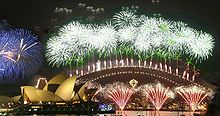This is your morning Open Thread. Pour your favorite beverage and review the past and comment on the future.
Find the past “On This Day in History” here.

January 1 is the first day of the year in the Gregorian calendar. There are 364 days remaining until the end of the year (365 in leap years).
During the Middle Ages under the influence of the Christian Church, many countries moved the start of the year to one of several important Christian festivals – December 25 (the Nativity of Jesus), March 1, March 25 (the Annunciation), or even Easter. Eastern European countries (most of them with populations showing allegiance to the Orthodox Church) began their numbered year on September 1 from about 988.
In England, January 1 was celebrated as the New Year festival, but from the 12th century to 1752 the year in England began on March 25 (Lady Day). So, for example, the Parliamentary record records the execution of Charles I occurring in 1648 (as the year did not end until March 24), although modern histories adjust the start of the year to January 1 and record the execution as occurring in 1649.
Most western European countries changed the start of the year to January 1 before they adopted the Gregorian calendar. For example, Scotland changed the start of the Scottish New Year to January 1 in 1600. England, Ireland and the British colonies changed the start of the year to January 1 in 1752. Later that year in September, the Gregorian calendar was introduced throughout Britain and the British colonies. These two reforms were implemented by the Calendar (New Style) Act 1750.
New Year’s Day
 Probably observed on March 1 in the old Roman Calendar, The World Book Encyclopedia of 1984, volume 14, page 237 states: “The Roman ruler Julius Caesar established January 1 as New Year’s Day in 46 BC. The Romans dedicated this day to Janus, the god of gates, doors, and beginnings. The month of January was named after Janus, who had two faces – one looking forward and the other looking backward.” This suggests that New Year’s celebrations are founded on pagan traditions. Some have suggested this occurred in 153 BC, when it was stipulated that the two annual consuls (after whose names the years were identified) entered into office on that day, though no consensus exists on the matter. Dates in March, coinciding with the spring equinox, or commemorating the Annunciation of Jesus, along with a variety of Christian feast dates were used throughout the Middle Ages, though calendars often continued to display the months in columns running from January to December.
Probably observed on March 1 in the old Roman Calendar, The World Book Encyclopedia of 1984, volume 14, page 237 states: “The Roman ruler Julius Caesar established January 1 as New Year’s Day in 46 BC. The Romans dedicated this day to Janus, the god of gates, doors, and beginnings. The month of January was named after Janus, who had two faces – one looking forward and the other looking backward.” This suggests that New Year’s celebrations are founded on pagan traditions. Some have suggested this occurred in 153 BC, when it was stipulated that the two annual consuls (after whose names the years were identified) entered into office on that day, though no consensus exists on the matter. Dates in March, coinciding with the spring equinox, or commemorating the Annunciation of Jesus, along with a variety of Christian feast dates were used throughout the Middle Ages, though calendars often continued to display the months in columns running from January to December.
Among the 7th century pagans of Flanders and the Netherlands, it was the custom to exchange gifts at the New Year. This was a pagan custom deplored by Saint Eligius (died 659 or 660), who warned the Flemings and Dutchmen, “(Do not) make vetulas, [little figures of the Old Woman], little deer or iotticos or set tables [for the house-elf, compare Puck] at night or exchange New Year gifts or supply superfluous drinks [another Yule custom].” The quote is from the vita of Eligius written by his companion, Ouen.
Most countries in Western Europe officially adopted January 1 as New Year’s Day somewhat before they adopted the Gregorian calendar. In England, the Feast of the Annunciation on March 25, was the first day of the new year until the adoption of the Gregorian Calendar in 1752. The March 25 date was known as Annunciation Style; the January 1 date was known as Circumcision Style, because this was the date of the Feast of the Circumcision, being the eighth day counting from December 25 when Christ was believed to be born. This day was christened as the beginning of the New Year by Pope Gregory as he designed the Liturgical Calender.
As you can see there were a lot of events that happened on this day over the centuries. Some of them significant, even momentous, some not so much but interesting as a kind of trivia. I am not even going to attempt to edit that list today.
Thank you all so much for your work and contributions to this site. We at The Stars Hollow Gazette and Docudharma wish you and yours a Happy, Healthy and Prosperous New Year.


 On this day in 1901,
On this day in 1901, 

 On this day in 1877, Crazy Horse and his warriors–outnumbered, low on ammunition and forced to use outdated weapons to defend themselves–fight their final losing battle against the U.S. Cavalry in Montana.
On this day in 1877, Crazy Horse and his warriors–outnumbered, low on ammunition and forced to use outdated weapons to defend themselves–fight their final losing battle against the U.S. Cavalry in Montana. On this day in 1789,
On this day in 1789,  Samuel Finley Breese Morse was born April 27, 1791, in Charlestown, Massachusetts. He attended Yale University, where he was interested in art, as well as electricity, still in its infancy at the time. After college, Morse became a painter. In 1832, while sailing home from Europe, he heard about the newly discovered electromagnet and came up with an idea for an electric telegraph. He had no idea that other inventors were already at work on the concept.
Samuel Finley Breese Morse was born April 27, 1791, in Charlestown, Massachusetts. He attended Yale University, where he was interested in art, as well as electricity, still in its infancy at the time. After college, Morse became a painter. In 1832, while sailing home from Europe, he heard about the newly discovered electromagnet and came up with an idea for an electric telegraph. He had no idea that other inventors were already at work on the concept.
 Before the bridge was built, the only practical short route between San Francisco and what is now Marin County was by boat across a section of San Francisco Bay.
Before the bridge was built, the only practical short route between San Francisco and what is now Marin County was by boat across a section of San Francisco Bay.  On this day in 1938, The
On this day in 1938, The 
 Probably observed on March 1 in the old Roman Calendar, The World Book Encyclopedia of 1984, volume 14, page 237 states: “The Roman ruler Julius Caesar established January 1 as New Year’s Day in 46 BC. The Romans dedicated this day to Janus, the god of gates, doors, and beginnings. The month of January was named after Janus, who had two faces – one looking forward and the other looking backward.” This suggests that New Year’s celebrations are founded on pagan traditions. Some have suggested this occurred in 153 BC, when it was stipulated that the two annual consuls (after whose names the years were identified) entered into office on that day, though no consensus exists on the matter. Dates in March, coinciding with the spring equinox, or commemorating the Annunciation of Jesus, along with a variety of Christian feast dates were used throughout the Middle Ages, though calendars often continued to display the months in columns running from January to December.
Probably observed on March 1 in the old Roman Calendar, The World Book Encyclopedia of 1984, volume 14, page 237 states: “The Roman ruler Julius Caesar established January 1 as New Year’s Day in 46 BC. The Romans dedicated this day to Janus, the god of gates, doors, and beginnings. The month of January was named after Janus, who had two faces – one looking forward and the other looking backward.” This suggests that New Year’s celebrations are founded on pagan traditions. Some have suggested this occurred in 153 BC, when it was stipulated that the two annual consuls (after whose names the years were identified) entered into office on that day, though no consensus exists on the matter. Dates in March, coinciding with the spring equinox, or commemorating the Annunciation of Jesus, along with a variety of Christian feast dates were used throughout the Middle Ages, though calendars often continued to display the months in columns running from January to December. On this day in 1759,
On this day in 1759,